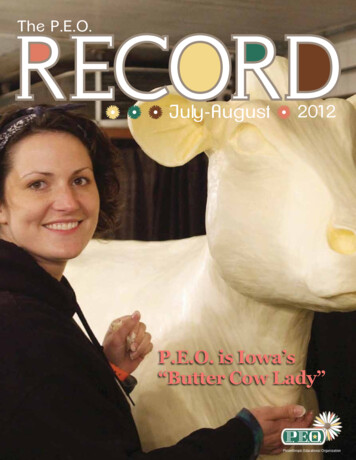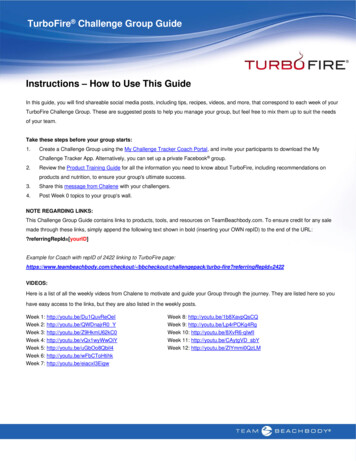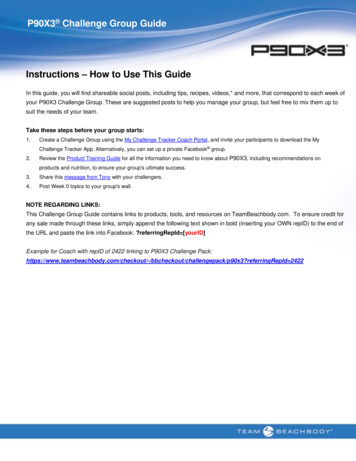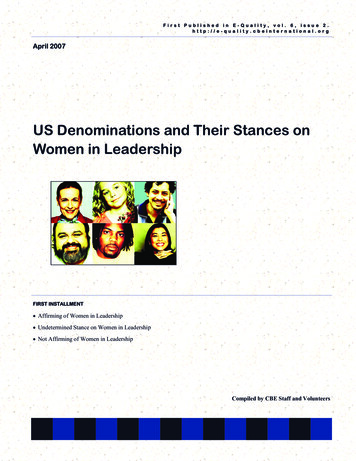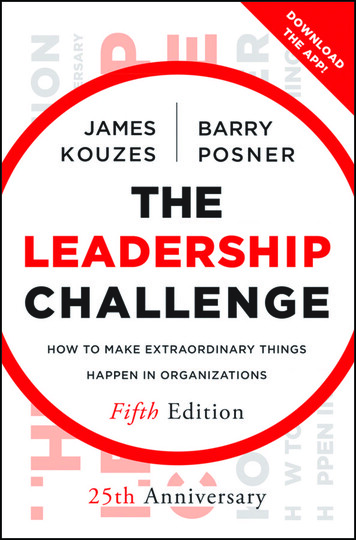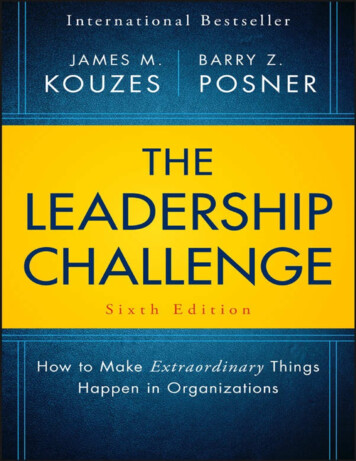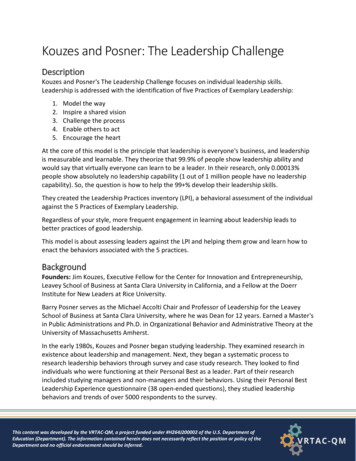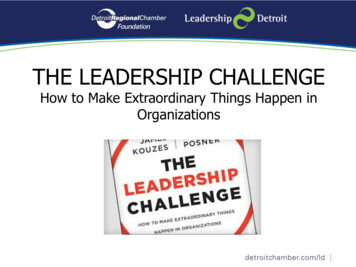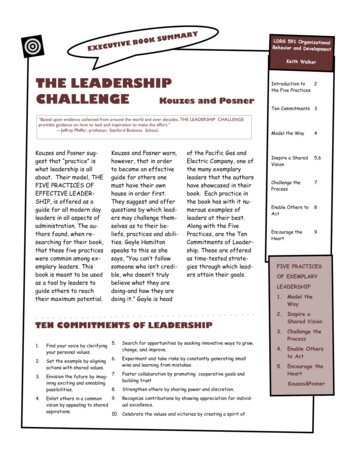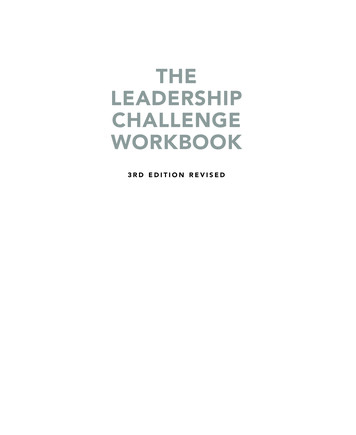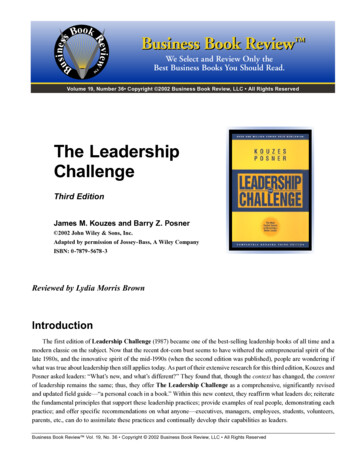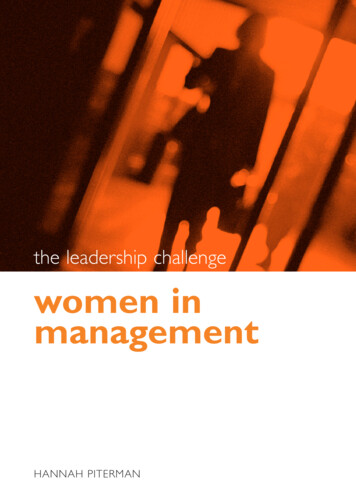
Transcription
the leadership challengewomen inmanagementHANNAH PITERMAN
the leadership challengewomen inmanagementHANNAH PITERMAN
T H EL E A D E R S H I PC H A L L E N G EW O M E NI NM A N A G E M E N THannah PitermanPhD, MEc, BEc (Hons)Dr Hannah Piterman is a consultant, and advisor to senior management and board levels in business, government and academia in the areas of organisational dynamics, leadership, and performance. Her doctoral and post doctoral research, strategic consulting and executive developmentdraws on more than 20 years of experience as executive in, and consultant to, business, governmentand university sectors.Dr Piterman is author of numerous public reports and journal articles, and is Honorary AssociateProfessor at Monash University. She has a doctorate in Organisation Dynamics and a Master degreein Economics.AcknowledgementsThis study was made possible by encouragement and financial assistance from 13 private companies, three government agencies, Monash University, the Women in Mining group within theMinerals Council of Australia and the Committee for Economic Development of Australia(CEDA). In particular it owes a great deal to the contribution of members from the ReferenceGroup, made up of distinguished corporate, government and university professionals and to theassistance of managers specialising in diversity and related issues in their organisations.This studywould not have been possible without the advice and support in gaining access to executives forinterview in their own and other organisations.The project was considerably more involved and intensive than originally anticipated.Accordingly it took longer than planned to complete. I am grateful for the patience of its sponsors.I would like to thank a number of people who have provided support and encouragement.Special thanks are due to Rosie Beaumont, for her assistance in the literature search, drafting, andprovision of comment. Special thanks also go to Melbourne Business School’s Professor AmandaSinclair and Diversity Manager Coles Group, Dr Katie Spearritt, for their edits, valuable insights,and suggestions on the penultimate draft. Thank you to Geoff Allen and Fergus Ryan who wereable to make the idea of this study a reality and to Geoff who provided ongoing feedback andencouragement as drafting proceeded.It has been a great pleasure to work with all those involved and I thank them for their support.Hannah Piterman March 20082
Reference group and organisation advisors AMP – Meredith Hellicar, Joanne Hawkins, Matthew Percival Australia Post – Linda Bardo Nicholls, Stephen Walter, Debra Dodgson Coles Group – Pamela Catty, Kerrina Watson, Dr Katie Spearritt CBA – Fergus Ryan, Barbara Chapman Deloitte Touche Tohmatsu – Giam Swiegers, Margaret Dreyer Department of Education, Employment and Workplace Relations (DEEWR)(previously Department of Education, Science & Training) – Lisa Paul, Dr Wendy Jarvie Department of Human Services (VIC) – Patricia Faulkner, Fran Thorn, Michael Debinski,Rachel Gold Freehills – Peter Butler, Andrea Bell Insurance Australia Group – Sam Mostyn, Michele Jackson Leightons – Penny Bingham Hall Macquarie Bank – Kris Neill, Sharon Ericsson Minerals Council of Australia – Melanie Stutsel Monash University – Professor Stephanie Fahey, Karen Haywood, Kay Gardner, BarbaraDalton Newmont Mining Corporation and Convenor, Women in Mining Group – Christine Charles Office for Women (Commonwealth) – Kerry Flanagan, Julia Burns, Sue Williamson,Lee Emerson St George Bank – Gail Kelly, Jeremy Griffith Westpac – Ann Sherry, Ilana Atlas The Allen Consulting Group – Geoff AllenNote: Some members of the reference group have since left these organisationsReport terminologyTo ensure confidentiality, generic position descriptions are used to identify participants.The term‘senior manager’ denotes executive and senior positions (CEO, managing director, general manager, partner, divisional/sectional head, senior manager). More junior participants are referred toas ‘managers’. Participants’ gender is also identified. The term corporate is used generically toinclude organisations in the private, public and tertiary sectors.3
forewordforewordThe new Australian Federal Parliament has a record number of women in key leadership positions. On the world stage there are also unprecedented numbers of women leading nations andthere is a strong possibility that the United States will elect its first women president.These events provide indisputable evidence not just of women’s talent and capability to lead,but that their contribution is now widely recognised and welcomed in political arenas and societies. While such changes are cause for celebration, they bring for me also a sense of loss. Thisloss derives from the evidence that the corporate world continues to miss out on much ofwomen’s potential leadership contribution. Women remain a tiny proportion of senior managersand leaders in Australian organisations and statistics reveal a plateauing in their numbers over thelast decade.This report, The Leadership Challenge: Women in Management, provides new depth and insightto understanding the continued absence of women from leadership roles in Australian business.In Trials at the Top, research undertaken by a group of corporate leaders and academics in theearly 1990s, we found that to understand women’s absence from corporate leadership, thereneeded to be a focus on the existing leadership culture. Yet undertaking such research is oftendifficult. Senior managers of both genders are often guarded about sharing obstacles on theirpaths to leadership and talking to women provides only a partial picture of the dynamics at work.Dr Piterman’s report answers these gaps in our understanding. It provides rich new information about what it’s like for men and women leading and aspiring to lead Australian organisations.Her interviewees speak with honesty, feeling and insight about their work and its impact on theirlives. Their experiences reveal that while organisational cultures contain strong expectations onleaders to work hard, their norms often mask deeply conformist behaviours in which anyone wholooks or acts differently comes under intense scrutiny. Says one executive ‘people fight the fight4
but don’t challenge the culture’. The report also documents in absorbing, intricate detail howpressures on men and women to conform, play out in gender stereotypes and sexual tensions.The results are bad for many women, who find fewer, narrower, more hazardous and personallycostly paths to the top. And they also have much wider effects, undermining the very potentialand quality of business leadership itself.Yet the research also shows how much of a difference innovative and committed leadershipcan make.The report provides practical advice on how leaders can create environments wherewomen with talent flourish in leadership.As an MBA teacher, I come across some truly amazingly talented and dedicated women andmen. Watching these students graduate, my fervent hope is that society and business will findways of growing their capabilities and desire to contribute. I believe this report will be a sourceof inspiration to all those taking up the challenge of creating innovative and inclusive leadershipcultures in which women and men can thrive in new ways .Amanda SinclairProfessor of Management (Diversity and Change)University of MelbourneJanuary 20085
T H EL E A D E R S H I PC H A L L E N G EW O M E N6I NM A N A G E M E N Tcontents1.0Executive summary. . . . . . . . . . . . . . . . . . . . . . . . . . . 81.1Background . . . . . . . . . . . . . . . . . . . . . . . . . . . . . . . . . . . . 81.2The study . . . . . . . . . . . . . . . . . . . . . . . . . . . . . . . . . . . . . . 91.3Findings. . . . . . . . . . . . . . . . . . . . . . . . . . . . . . . . . . . . . . . . 91.4The diversity challenge. . . . . . . . . . . . . . . . . . . . . . . . . . 122.0Methodology. . . . . . . . . . . . . . . . . . . . . . . . . . . . . . . 142.1Background . . . . . . . . . . . . . . . . . . . . . . . . . . . . . . . . . . . 142.2Underlying premise for research . . . . . . . . . . . . . . . . . 142.3Method . . . . . . . . . . . . . . . . . . . . . . . . . . . . . . . . . . . . . . 152.4Findings . . . . . . . . . . . . . . . . . . . . . . . . . . . . . . . . . . . . . . 152.5Participants . . . . . . . . . . . . . . . . . . . . . . . . . . . . . . . . . . . 152.6Steering committee . . . . . . . . . . . . . . . . . . . . . . . . . . . . 163.0Context. . . . . . . . . . . . . . . . . . . . . . . . . . . . . . . . . . . 173.1A changing social environment . . . . . . . . . . . . . . . . . . . 173.2The political environment . . . . . . . . . . . . . . . . . . . . . . . 183.3A changing business environment . . . . . . . . . . . . . . . . 193.4Women in business . . . . . . . . . . . . . . . . . . . . . . . . . . . . 203.5The challenges for leadership . . . . . . . . . . . . . . . . . . . . 213.6Conclusion. . . . . . . . . . . . . . . . . . . . . . . . . . . . . . . . . . . . 214.0The business response to women . . . . . . . . . . . . . . 224.1The implementation debate . . . . . . . . . . . . . . . . . . . . . 224.2The leadership challenge . . . . . . . . . . . . . . . . . . . . . . . . 254.3Implementation practices . . . . . . . . . . . . . . . . . . . . . . . 254.4Conclusion. . . . . . . . . . . . . . . . . . . . . . . . . . . . . . . . . . . . 275.0Strategies for change . . . . . . . . . . . . . . . . . . . . . . . . 285.1The business case for diversity . . . . . . . . . . . . . . . . . . . 285.2Contemporary human resources . . . . . . . . . . . . . . . . . 295.3Selection quotas . . . . . . . . . . . . . . . . . . . . . . . . . . . . . . . 295.4Mentoring and networking . . . . . . . . . . . . . . . . . . . . . . 295.5Raising awareness . . . . . . . . . . . . . . . . . . . . . . . . . . . . . . 305.6Childcare . . . . . . . . . . . . . . . . . . . . . . . . . . . . . . . . . . . . . 305.7Infrastructure supports for parents . . . . . . . . . . . . . . . 305.8Flexible work opportunities . . . . . . . . . . . . . . . . . . . . . 315.9Leave entitlements . . . . . . . . . . . . . . . . . . . . . . . . . . . . . 416.0The drivers of business . . . . . . . . . . . . . . . . . . . . . . 326.1The dominant corporate culture . . . . . . . . . . . . . . . . . 326.2The contemporary business model . . . . . . . . . . . . . . . 366.3Conclusion. . . . . . . . . . . . . . . . . . . . . . . . . . . . . . . . . . . . 37
7.0Leadership and authority . . . . . . . . . . . . . . . . . . . . . 387.1Leadership and masculinity . . . . . . . . . . . . . . . . . . . . . . 387.2Intelligence . . . . . . . . . . . . . . . . . . . . . . . . . . . . . . . . . . . . 397.3Emotion . . . . . . . . . . . . . . . . . . . . . . . . . . . . . . . . . . . . . . 417.4Communication . . . . . . . . . . . . . . . . . . . . . . . . . . . . . . . 437.5Physicality and sexuality . . . . . . . . . . . . . . . . . . . . . . . . . 447.6Acknowledging gender in the workplace . . . . . . . . . . 467.7Collusion with the dominant culture . . . . . . . . . . . . . . 477.8Regulating invisible barriers . . . . . . . . . . . . . . . . . . . . . . 497.9Conclusion. . . . . . . . . . . . . . . . . . . . . . . . . . . . . . . . . . . . 498.0Work/life balance . . . . . . . . . . . . . . . . . . . . . . . . . . . 508.1Recognising the benefits of flexibility . . . . . . . . . . . . . . 518.2A more sustainable business model. . . . . . . . . . . . . . . 528.3Women’s engagement with flexibility . . . . . . . . . . . . . 528.4The leadership challenge . . . . . . . . . . . . . . . . . . . . . . . . 578.5Conclusion. . . . . . . . . . . . . . . . . . . . . . . . . . . . . . . . . . . . 589.0Dynamics . . . . . . . . . . . . . . . . . . . . . . . . . . . . . . . . . 599.1Understanding the dynamics of hierarchy. . . . . . . . . . 599.2Managing relationships . . . . . . . . . . . . . . . . . . . . . . . . . . 639.3Dynamics between the sexes . . . . . . . . . . . . . . . . . . . . 669.4Dynamics between women . . . . . . . . . . . . . . . . . . . . . 689.5Conclusion. . . . . . . . . . . . . . . . . . . . . . . . . . . . . . . . . . . . 7010.0Successful women. . . . . . . . . . . . . . . . . . . . . . . . . . . 7110.1What it takes. . . . . . . . . . . . . . . . . . . . . . . . . . . . . . . . . . 7110.2Conclusion. . . . . . . . . . . . . . . . . . . . . . . . . . . . . . . . . . . . 7311.0The diversity challenge . . . . . . . . . . . . . . . . . . . . . . . 7411.1Strategies for leadership . . . . . . . . . . . . . . . . . . . . . . . . 7411.2The honest conversation. . . . . . . . . . . . . . . . . . . . . . . . 7511.3Taking action . . . . . . . . . . . . . . . . . . . . . . . . . . . . . . . . . . 7811.4Conclusion. . . . . . . . . . . . . . . . . . . . . . . . . . . . . . . . . . . . 78Postscript . . . . . . . . . . . . . . . . . . . . . . . . . . . . . . . . . 79References . . . . . . . . . . . . . . . . . . . . . . . . . . . . . . . . 80Appendices . . . . . . . . . . . . . . . . . . . . . . . . . . . . . . . . 867
1.0executive summary1.1 BackgroundThe presence and status of women in paid employmenthas improved dramatically over the last half century.However, the progression of professional women intopositions of leadership has been slow. Within Australia,women currently represent 12 percent of ASX200 executive managers. Five women have been appointed tochief executive level in ASX200 companies since 2004.The number of women holding chief executive positions(or equivalent) in the public and tertiary sectors is morepromising. Nevertheless, women find it more difficult torise to positions of leadership in environments that arehighly male-dominated, irrespective of the sector ofemployment.There is a strong business case for enhancing the contribution of executive women to the achievement oforganisational objectives.There is a parallel ethical, publicgood and humanitarian case for the participation ofwomen at executive level. Rising social expectations forequal opportunity can no longer be ignored. Significant8change will require a committed leadership focus to theeconomic and broader performance dividend that canbe achieved by attracting and retaining quality womenmanagers and optimising the contribution of women inmanagement.Over the last decade, an increasingly tight and globallycompetitive labour market has seen the business community make genuine efforts to promote and retainwomen. A number of Australia’s leading organisationshave adopted globally recognised strategies to facilitategender diversity within their workforces.While the focusof this study is gender diversity, many of the issues thestudy raises relate to dynamics in the wider domain,which result in the exclusion of certain groups from benefits afforded to the dominant culture.This study was undertaken by Dr Hannah Pitermanand initiated through a number of conversations withGeoff Allen, Fergus Ryan and a number of senior executive men and women who agreed to support the studyfinancially and who formed the steering committee.The objective of the study is to explore unconsciousand subtle inhibitors to the positive experience and fullutilisation of women in executive and management posi-
1.0E X E C U T I V E S U M M A RYtions. The analysis considers the powerful organisationalelements that shape the experiences of women in corporate Australia. The findings will contribute to a widerappreciation of implicit barriers to women’s careerdevelopment and retention, and help organisationsengage with the diversity agenda in Australia.The findings show that impediments to female advancement can be attributed to a number of interacting factors.These include short-term business drivers; cultures thatundermine the female presence through narrow notionsof ‘cultural fit’ and masculine leadership constructs thatexclude women; complex dynamics around managingstrategic relationships; and work/life balance issues.vent the optimisation of female contributions to businessoutcomes. The study finds that unspoken rules andarrangements of mainstream corporate Australia set particularly narrow parameters for leadership.The prevailingprofile of the good business leader reflects the stereotypical traits of masculinity. Preoccupation with immediate financial performanceencourages a left brain bias that favours hard skills,such as rationality, expediency, and numeracy (typicallyassociated with masculinity) over less tangible, soft skillssuch as relationship-building. These cultures tend tohave a greater tolerance for bullish ‘command and control’ communication. A culture of competition generates a winner psyche.Individuals strive to align with success and fear marginality. Critique is avoided and difference is often notaccommodated. In an attempt to fit in, individual needs,particularly the needs of women, can be suppressed. Team-play in competitive, results-focused environments requires skills in forming strategic relationshipsand navigating organisational politics that often requireseparation of the personal from the professional. Menand women who are not adept at ‘playing the game’are less successful. A 24/7 work ethic includes a low tolerance for the intersection of the commercial and domestic worlds, particularly at the senior level. A ‘round the clock’ culturestruggles to accommodate parenthood, which impactson women who have prime carer responsibility.When business is viewed through a narrow masculineprism, the skills and traits attributed to the feminine donot align with business essentials. Moreover, genderstereotyping excludes women from leadership roles. The alignment of numeric competency with intellect,combined with a gender stereotypical assumption thatwomen are numerically less competent, encourages aview of women as innately lacking business acumen. The communication and decision-making styles attributed to women, such as being inclusive and collegial,are seen as incompatible with desired leadership traitsof decisiveness and expediency. Women’s reluctance (and/or inability) to enter into agame of strategic survival and aggressive personal politics is perceived as a weakness and lack of ambition. Working mothers are excluded from key roles, projects and opportunities due to a work structure and aculture that does not accommodate their needs.1.3.1 Business drivers1.3.2 Life in a straight jacketThe current market focus on short-term financial returnscreates incentives that mitigate against longer-term andmore sustainable corporate performance. Powerfulshort-term business drivers influence business operations, corporate culture, and the type of leadershipattributes that are sought and rewarded – all which pre-The study finds that most women face numerous culturaldilemmas when they aspire to success.The business environment is dominated by a limiting female archetype thatplaces women in a cultural ‘straight jacket’. Few womenare able to seamlessly navigate organisational life.Women are subjected to intense scrutiny that tran-1.2 The studyManagement literature refers to unspoken rules andarrangements that govern workplace structure and gender dynamics. These elements of organisational cultureare subjective yet powerful. They have the potential tolimit women’s promotional opportunities and undermine their experience at the workplace. A number ofstudies internationally and in Australia have identifiedcorrelations between a multitude of structural and cultural forces and the under-representation of women atthe senior level. Significant Australian research on the culture of leadership and authority in corporate environments has revealed the role of gender, sexuality, andpower in shaping the experience for women.The study pursues this line of investigation to furtheraddress the gap in our understanding of the impact oforganisational settings on women’s work experiences.The analysis is based on 115 in-depth interviews withwomen and men in middle and senior management.These have been sought from a broad range of industrysectors and disciplines including private, public and tertiary sectors. A number of suggestions are made to moreeffectively support interventions to enhance diversity inleadership across all sectors.1.3 Findings9
T H EL E A D E R S H I PC H A L L E N G EW O M E NI NM A N A G E M E N Tscends performance.They are judged on appearance andcommunication style. Highly-talented women can besidelined and excluded from leadership positions basedon a perception of poor cultural fit.A number of women in the study have attempted toadjust to the dynamics of a narrow cultural environment.They accept the challenge of life in a straight jacket andinternalise the responsibility for their poor cultural fit.Women become sensitive to their marginality at a senior level and to the lack of cultural accommodation.Theirvisibility renders them highly vulnerable.They display theanxieties of the minority in infiltrating and surviving at thetop. Some women resort to the contrived stance of an‘honourary bloke’. They adopt hard and aggressivedemeanours, talk sport and suppress authentic femalecharacteristics. A number of women display guilt andsecrecy around their responsibilities as mothers and carers. They fear association with women’s programs andaffirmative action initiatives, as these highlight their ‘otherness’ and denote their need for special treatment. In aculture of winners, women seek to adapt to the normsof the winning group.A high level of personal adaptation and compromisenot only interferes with women’s performance potential,but rarely proves a successful strategy. Some of the meninterviewed perceived the acquirement of ‘blokey’ attributes by women as fraudulent and unnatural behaviour.While women face tacit cultural barriers to demonstrating their authentic value, their attempts to accommodatethe masculine model of authority encourage suspicion,derision, and cultural isolation.For some women, the relentless level of scrutinyresults in burnout and leads them to exit organisations,resulting in the loss of a valuable talent pool.1.3.3 Managing relationshipsManaging relationships is intrinsic to organisational life.Good relationships are fundamental to career sustainability and advancement. As it is often men who hold positions of power, women who wish to succeed mustestablish good relationships with men.They must becomeconversant with the unspoken rules and codes of behaviour that shape this strategic relationship dynamic.Mateship is the glue that binds. Mateship has long beenembedded in the Australian psyche. It connotes powerful frontier imagery that upholds masculine fantasies ofpower and sexuality. Historically, the loyalty of mateshipextended only so far as those fitting the standard ofAustralian manhood. It represented an exclusive anddivisive ideology that has its genesis in a notion of racialhomogeneity that saw ‘real Aussies’ as Anglo-Celts.Mateship did not extend to women. It firmly affirmed thedichotomy of the sexes and enshrined traditional sexualstereotypes of man as the warrior and creator, andwoman as subservient (Hirst, 1999; Lake, 1992).10Women do not generally fit into a culture of mateship.They are often absent from networking opportunitiessuch as drinks at the pub or games of golf. They do notrun with ‘the pack’. They do not possess men’s innateability to form strategic alliances within hierarchical environments. Men’s early socialisation provides them withthe capacity to negotiate hierarchy. The experience ofsafety and camaraderie in the group provides a powerfulantidote to the loss of autonomy that hierarchydemands.‘Mateship’ provides the equaliser in competitiveand hierarchical cultures.Women’s failure to gain the full strategic benefit fromwork relationships results in their exclusion from theopportunities that these relationships afford. While theyrecognise the strategic potential of informal networksand alliances, they are often not privy to the workings ofinformal career pathways. The ‘tap on the shoulder’ thatcan open doors is elusive to most women.Women’s entry into leadership career paths is moredifficult in male domains where ‘like attracts like’ and ‘likebegets like’. These subtle and often unconscious dynamics influence how talent is recognised and rewarded.They can thwart interventions designed to supportrecruitment and promotion of women, making it difficultfor women to be recognised and rewarded. Meritocracyand transparency remain statements of policy; idealisednotions that are difficult to operationalise in the face ofcorridor politics and informal communication systems.For women, developing strategic relationships withsenior figures is essential to gaining entré into informalnetworks and executive environments. A relationshipwith a key senior player can provide a woman with alevel of visibility and recognition that she would struggleto attain on her own. While successful women are oftenperceived as obvious role models for ambitious women,a paucity of positive female role models exists.Perceptions of women’s experiences at the top can benegative and not all successful women are natural mentors. Given the gender balance of the power elite, astrategic relationship with a key senior male is often necessary if an ambitious woman is to realise success.Primitive dynamics drive relationships between thesexes.These dynamics are complex and unconscious.Thefather/child and husband/wife interplays are prevalent,particularly in traditional organisational settings wheremen hold power. Failure to meet unconscious expectations and fulfil one’s archetypal role in the interplay canrender both men and women targets of aggression.Women, however, are particularly vulnerable given powerinequality in most organisations. Being attuned to thesedynamics can assist women understand hostile behaviour,and can take some of the pressure off women who oftenblame themselves when relationships are not working.Dependence on male advocacy renders women vulnerable. In order to retain the favour of a ‘champion’, awoman treads a fine line to ensure she is not perceived
1.0E X E C U T I V E S U M M A RYas a threat. It is incumbent upon her to demonstrate thegood judgement of a male advocate through the highestlevel of achievement. A woman who steps outside herdesignated role or does not prove her worth may attractaggression or rejection from the senior male advocate.Some women have referred to deeper dynamics inthe way competition expresses itself among women atall levels of the organisation. While women increasinglyembrace ambition, competition and success as part ofthe competitive world of office politics, many have difficulty managing overt competitive dynamics, particuarlywhen it involves other women.1.3.4 Work/life balanceIncreasing numbers of Australians are struggling toaccommodate the demands of work and family life.Research reveals links between poor flexibility and theloss of female talent from management. Australianresearch has found that while highly skilled women infull-time employment are more likely to have access toflexible work opportunities, resistance to flexibilityincreases at the senior end of the organisational hierarchy. Women in management are less inclined to take upflexibility options than women at general staff level.The study finds that Australian business is undertakinginitiatives that recognise the flexibility needs of professional women. Indeed, large private employers are gaining recognition for their design and delivery of flexiblework initiatives. Nevertheless, the incorporation of diversity into business continues to be a major challenge.Thefull-time worker model underpins the structure of workforce contribution. Choosing flexibility suggests a lesserengagement with the workforce. Flexibility options arenot meeting the needs of senior female talent.Ultimately, it is women who are responsible for managing the work/life balance. Research indicates thatwomen typically bear a disproportionate amount ofresponsibility for home and family. Where a 24/7 imperative drives an organisation’s work ethic, there is little cultural tolerance for the intersection of the commercialand domestic worlds. Time spent in the office continuesto be seen as a powerful indicator of work commitmentthat impacts on family life, health, and productivity ofmen and women at work.To the extent that flexibility options are provided, theonus remains on the individual to accommodate thedemands of the workplace and manage employerexpectations. A piecemeal approach to implementingflexibility strategies places the onus on women to negotiate work/life balance. This renders them particularlyvulnerable in cultural settings where diversity policiesare fluid, ambiguous and open to interpretation by individual managers.A number of the most successful women identified inthe study do not have children. Others stress the valueof supportive partners, some of whom have made sacrifices in their own careers. Some women engage in acomplex juggling act that is not sustainable.The study finds that stigmatisation of flexibility inhibitsthe effective uptake of initiatives by women. Womenwho negotiate a part-time return to work may find thattheir full-time responsibilities have not diminished.However, they avoid negotiating for a more manageableworkload and accept a ‘Clayton’s’ flexibility. Others aresensitive to problems associated with working in unconventional ways, such as working from home, and chooseto remain in the mainstream.They see a danger in isolating themselves from office life and daily interaction withcolleagues and communication processes. Female talentis ultimately lost as working mothers fail to achieve effective flexible work arrangements and abandon demandingcorporate careers.Flexibility needs to move from the margins of organisational life. It needs to be treated as a strategic intervention designe
This report,The Leadership Challenge:Women in Management, provides new depth and insight to understanding the continued absence of women from leadership roles in Australian business. In Trials at the Top, research undert

